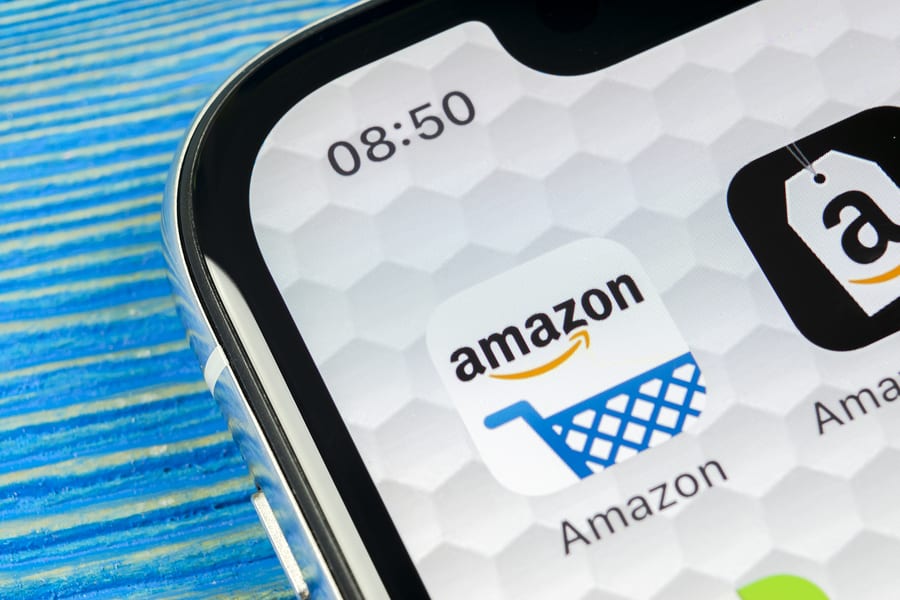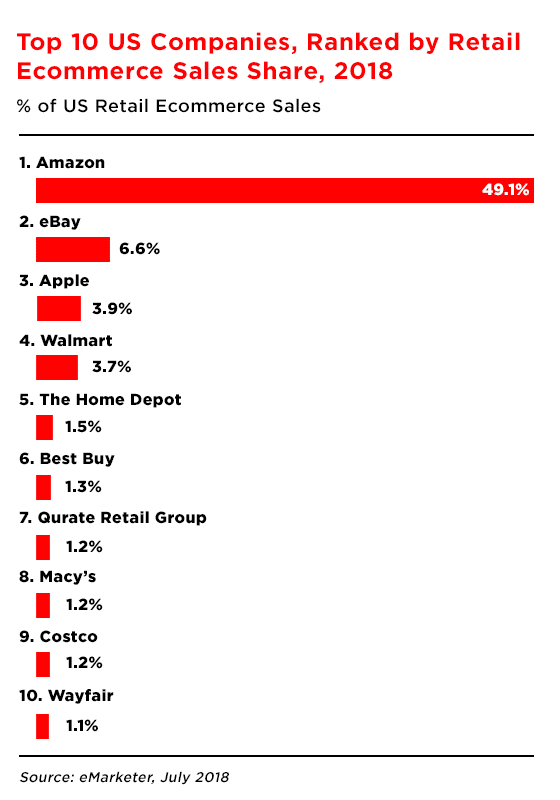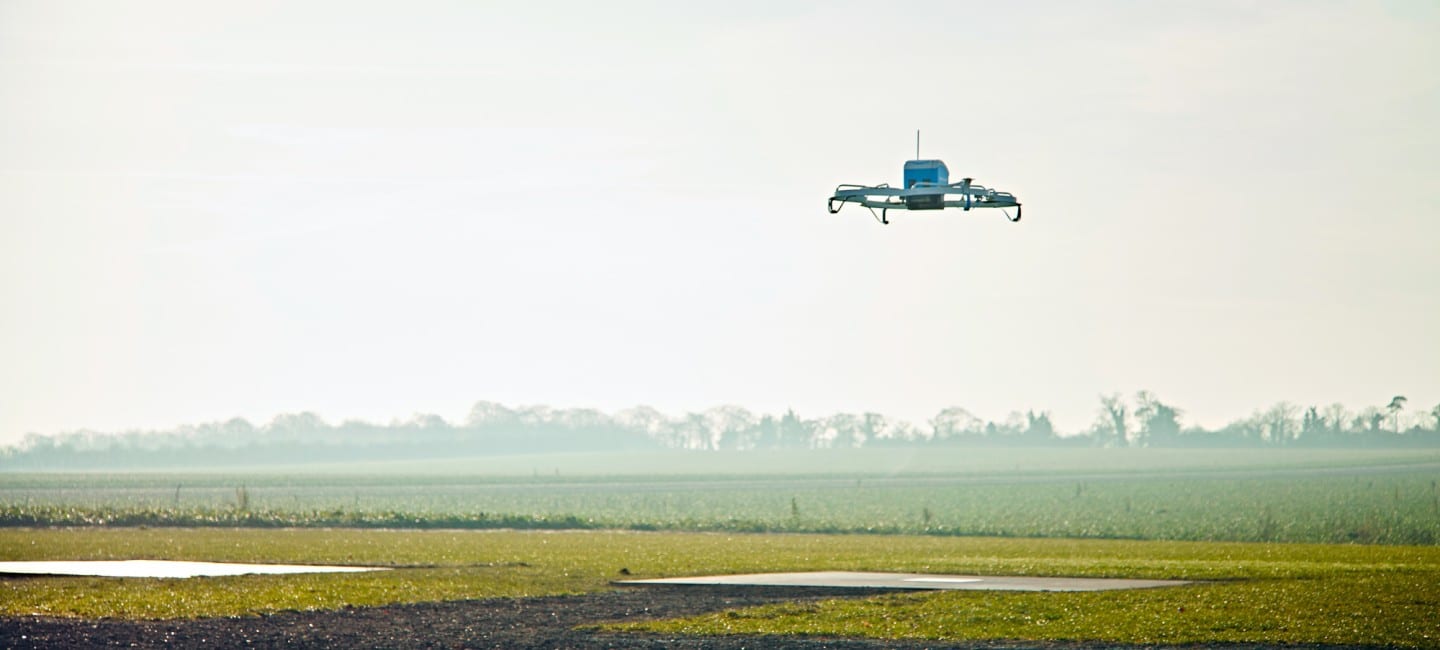Amazon’s Record-Setting Year in 2018

We’ve already covered in detail how Amazon was King of the Jungle in 2017. But in 2018, Amazon also set new all-time retailing records, among a slew of others, in an upward trend that shows no sign of slowing down.
Just how big was Amazon’s record-setting year? Read on to learn more.
Amazon Was 50% of Ecommerce in 2018
To put things into perspective, an eMarketer report from late last year finds that Amazon hauled in half of all ecommerce sales in 2018, generating more than $258 billion, representing a healthy year-over-year growth rate of 29.2%. What’s more, marketplace sales topped out at about 68% while direct sales came in strong at 32%.
“The continued growth of Amazon’s Marketplace makes sense on a number of levels,” eMarketer principal analyst Andrew Lipsman said in a press release. “More buyers transacting more often on Amazon will naturally attract third-party sellers. But because third-party transactions are also more profitable, Amazon has every incentive to make the process as seamless as possible for those selling on the platform.”

New Prime Day Records
Did you know that 2017’s Amazon Prime Day was one of the biggest retailing days of the year? And without a doubt, 2018’s Amazons Prime Day also set new all-time records, too.
Notably:
- Prime mobile app sales nearly doubled.
- The echo dot saw a 700% sales increase.
- Traffic grew by 5% YoY resulting 113 million clicks per second.
- More than 55 million Prime members made a purchase.
- Around 50% of the world’s largest retailers had an item on sale.
- Prime Day was extended from 24 hours to 30 hours.
- Prime Members also saved millions on purchases at Whole Foods.
According to Supermarket News, Prime Day in 2018 resulted in more than 100 million products being sold in less than 30-hours, in a record-setting $3.4 billion haul for Amazon. All told, this represents a staggering 42% increase from last year—which generated just $2.4 billion by comparison.
Surprisingly, small and medium businesses were among the biggest winners on Prime Day this past year, with Amazon reporting that they generated more than $1 billion in sales from the total haul, accounting for about 30% of all transactions across the marketplace.
But why did Amazon add 12 hours to Prime Day for 2018?
“Extending Prime Day to a day-and-a-half this year allowed us to further reward members with unbeatable deals, access to exclusive new products and unforgettable experiences that highlight the many benefits of a Prime membership,” Jeff Wilke, CEO of worldwide consumer at Amazon, said in a press release. “All of this was made possible because of our many valued associates, the global team that continues to make Prime Day bigger and better.”
Cyber Monday Was a Hit
While Prime Day is one of the biggest online shopping days of the year, by and far, Cyber Monday is the official ecommerce shopping holiday. For 2018, Cyber Monday sales set new all-time records, with CNBC reporting more than $7.8 billion in total sales overall across all of ecommerce.
But guess what? Amazon raked in about half of all those sales, tacking on another $3.4 billion to its annual take. Amazon said that for 2018, Cyber Monday set its single day sales record, with customers purchasing 180 million items over the course of just 24 hours. That’s 80 million more purchases than were generated on Prime Day this past year giving Amazon the top two slots for single day sales records in ecommerce for 2018!
All said and done, the holiday shopping rush resulted in a more than $73 billion haul for Amazon, helping the online marketplace close out the Black Friday and Cyber Monday shopping rushes with a definitive bang.
Jeff Bezos’ Became World’s Richest Man
Some of the biggest financial news of the year revolved around Amazon’s founder and CEO, Jeff Bezos. As of late October, 2018, CNBC declared that Bezos was the world’s richest man, with a net worth estimated at around $90 billion.
In single day, the report emphasized, he netted an additional $7 billion to his net worth, all driven by strong pre-holiday sales. By the end of 2018, just two short months later, he would nearly double that net worth to $180 billion, according to a report by Investopedia.
A quick look at a Forbes report concurs these findings but also shows updated numbers for real-time, estimating Bezo’s net worth to be in the ballpark of about $136 billion as of the writing of this report, putting him at the very top of the Forbes 400.

What Happened to Amazon Prime Air?
Remember Amazon Prime Air? If you don’t, we’ll catch you up to speed in a jiffy:
Amazon Prime Air is a package delivery service that’s being designed by Amazon. The logistics and the details are still being fine-tuned. Basically, small delivery drones will be used to deliver packages from metropolitan fulfillment centers to businesses and homes within a predetermined geographical range within 30 minutes from the order being placed.
According to Paul Misener, Amazon’s vice president for global public policy, “[Amazon] Prime Air is a future delivery service that will get packages to customers within 30 minutes of them ordering it online at Amazon.com. The goals we’ve set for ourselves are: The range has to be over 10 miles. These things [delivery drones] will weigh about 55-pounds each, but they’ll be able to deliver parcels that weigh up to five-pounds. It turns out that the vast majority of the things we sell at Amazon weigh less than five-pounds.”
After years of testing, Prime Air is in motion in very limited circumstances. Namely, the technology has been held up by regulations on air traffic control that are imposed by the FAA, reports DroneDJ. This has resulted in Prime Air being tested in other regions, such as Australia and the UK, where regulations are more favorable.

When can you expect it and what will it do?
According to Amazon:
“Today, we are rapidly experimenting and iterating on Amazon Prime Air inside our next generation research and development labs, working to make our vision a reality. It may sound like science fiction, but it’s real.
Putting the system into service will take some time, but one day seeing Prime Air vehicles will be as normal as seeing mail trucks on the road. Currently under development in the United States, the United Kingdom, Austria, France, and Israel, Amazon will use Prime Air to deliver packages that weigh up to five pounds—which make up nearly 90% of the items we sell—at distances of 10 miles or more.”
Amazon’s Outlook for 2019
Amazon’s outlook for 2019 is one of the healthiest of any corporation in the world, according to a recent Forbes report. Towards the end of 2018, Amazon was the most valuable company in the world, with an estimated total worth of $2 trillion (that’s trillion with a “T”). But Forbes is predicting that by the end of this year, the company will more than double its worth, topping the charts at $4 trillion come the close of Q4.
Given that the company has dramatically expanded its operations worldwide, owns the largest web services provider, streaming video service and online retail marketplace, not to mention Whole Foods, Ring, a private airline for its deliveries—and a slew of other acquisitions it’s made, is in the process of making or will make this year—these predictions don’t seem that far-fetched.
What’s more, given that Amazon was able to double its value last year from $1 trillion to $2 trillion, it’s safe to say that once again, the most valuable and solvent company in the world at the end of 2019 will be Amazon, Inc.
Cheers to another record-setting year!
What You Should Do Now
Here are 3 ways ReadyShipper X can help you instantly cut shipping costs, keep delivery promises, and scale fulfillment without adding headcount:
Schedule a Demo – See how ReadyShipper X combines on-premise speed with cloud flexibility to ship your orders faster and cheaper, delivering the speed customers expect at costs that protect your margins.
Start Your Free Trial of ReadyShipper X (No CC Required) – Get up and running in minutes with instant access to multi-carrier rate shopping, smart automation, and enterprise features.
Try ReadyCloud at No Cost – Why manage shipping and returns separately? Get ReadyShipper X, ReadyReturns, and more in one unified platform for faster fulfillment, fewer headaches, and happier customers.
Share On:







